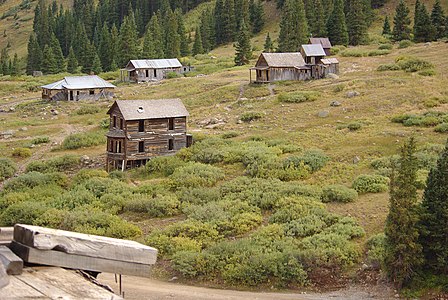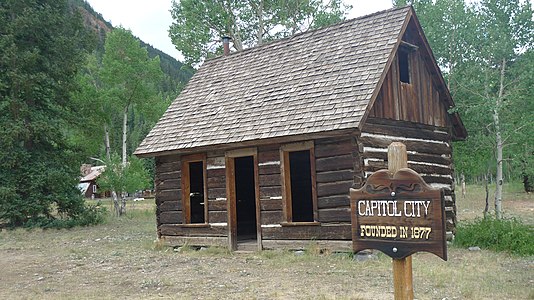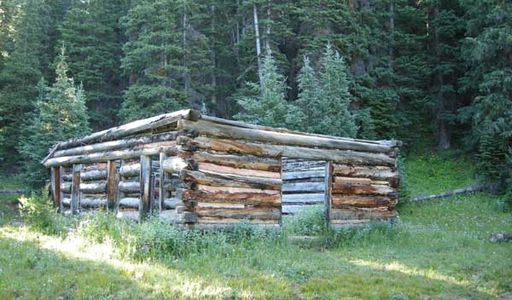List of ghost towns in Colorado

This is a list of some notable ghost towns in the U.S. State of Colorado. A ghost town is a former community that now has no year-round residents or less than 1% of its peak population. Colorado has over 1,500 ghost towns, although visible remains of only about 640 still exist. Due to incomplete records, no exhaustive list can be produced.
Abandonment
[edit]Colorado ghost towns were abandoned for a number of reasons:
- Mining towns were abandoned when the mines closed, largely due to the devaluation of silver in 1893.
- Mill towns were abandoned when the mining towns they serviced closed.
- Farming towns on the eastern plains were often deserted due to rural depopulation.
- Coal towns were abandoned when the coal (or the need for it) ran out.
- Stage stops were abandoned when the railroad came through.
- Rail stops were deserted when the railroad changed routes or abandoned the spurs.
Others were abandoned for more unusual reasons. Some were resort towns which never brought in enough tourists. At least seven former townsites are now underwater, caused by the creation of reservoirs; a few are covered in mining tailings, as noted below. Of the list below, some involve settlements with visible tangible remains such as structures or cemeteries, while the precise location of others is known only through maps and historic accounts.
Table
[edit]This is a sortable table of some of the ghost towns in Colorado. Select the OpenStreetMap link in the box at right to view a map showing the location these towns.
Gallery
[edit]-
Abandoned buildings at Animas Forks, Colorado
-
Houses along Ashcroft, Colorado's Main Street, 2007
-
Token coin with the value of $1.00, issued by the Rawley Mine Commissary in Bonanza, Colorado
-
Caribou, Colorado circa 1911
-
Caribou, Colorado in 2005
-
The remains of an old cabin at Dyersville, Colorado
-
An abandoned house in Eastonville, Colorado
-
The Arcade Saloon in Eldora, Colorado in 1898
-
Remains of the old ore mill in Eureka, Colorado
-
Remains of the Bassick silver mine, Querida, Colorado
-
Saint Elmo, Colorado in 2005
See also
[edit]- List of places in Colorado
- Bibliography of Colorado
- Geography of Colorado
- History of Colorado
- Index of Colorado-related articles
- List of Colorado-related lists
- Outline of Colorado
Notes
[edit]- ^ a b c d e f g h i j k l m n o p q r s t u v w x y z aa ab ac ad ae af ag ah ai aj ak al am an ao ap aq ar as at au av aw ax ay az ba bb bc bd be bf bg bh bi bj bk bl bm bn bo bp bq br bs bt bu bv bw bx by bz ca cb cc cd ce cf cg ch ci cj ck cl cm cn co cp cq cr cs ct cu cv cw cx cy cz da db dc dd de df dg dh di dj dk dl dm dn do dp dq dr ds dt du dv dw dx dy dz ea eb ec ed ee ef eg eh ei ej ek el em en eo ep eq er es et eu ev The year the local post office opened[2][3]
- ^ a b c d e f g h i j k l m n o p q r s t u v w x y z aa ab ac ad ae af ag ah ai aj ak al am an ao ap aq ar as at au av aw ax ay az ba bb bc bd be bf bg bh bi bj bk bl bm bn bo bp bq br bs bt bu bv bw bx by bz ca cb cc cd ce cf cg ch ci cj ck cl cm cn co cp cq cr cs ct cu cv cw cx cy cz da db dc dd de df dg dh di dj dk dl dm dn do dp dq dr ds dt du dv dw dx dy dz ea eb ec ed ee ef eg eh ei ej ek el em en eo ep eq er es et eu ev ew ex ey ez fa fb fc fd fe ff fg fh fi fj fk fl fm fn fo fp fq fr fs ft fu fv fw fx fy fz ga gb gc gd ge gf gg gh gi gj gk gl The year the local post office closed[2][3]
- ^ a b c d e f g h i j k l m n o p q r s t u v w x y z aa ab ac ad ae af ag ah ai aj ak al am an ao ap aq ar as at au av aw ax ay az ba bb bc bd be bf bg bh bi bj bk bl bm bn bo bp bq br bs bt bu The year the community was founded
- ^ a b c d e f g h i j k l m n o p q r s The year the community was abandoned
- ^ The Granada War Relocation Center opened on August 27, 1942.
- ^ The Granada War Relocation Center closed on October 15, 1945.
- ^ Located at an elevation of 11,185 feet (3,409 m), the Animas Forks, Colorado Territory post office (became Animas Forks, Colorado on August 1, 1876) was the highest in the United States from February 8, 1875 to February 9, 1876 and again from September 25 to October 15, 1879.
- ^ On November 28, 1859, the Provisional Government of the Territory of Jefferson created 12 counties, with Arapahoe City as the first seat of Jefferson County, Jefferson Territory.[4] On January 17, 1860, Arapahoe City shortened its name to Arapahoe.[2] On November 6, 1860, the Jefferson Territory moved the seat of Jefferson County to Golden City.
- ^ Located at an elevation of 12,230 feet (3,728 m), Arastra, Colorado was the highest elevation town to ever have a United States post office.
- ^ Auraria is now a part of the City and County of Denver.
- ^ Auraria was organized on November 6, 1858.
- ^ a b On December 3, 1859, the Provisional Government of the Territory of Jefferson consolidated the towns of Denver City, Auraria, and Highland into the City of Denver, Auraria, and Highland. Auraria and Highland are now neighborhoods of the City and County of Denver.
- ^ On November 1, 1861, the Territory of Colorado created 17 original counties, with Autobees Plaza as the original seat of Huerfano County, Colorado Territory, serving until 1868. Autobees Plaza is now located in Pueblo County.
- ^ On September 12, 1865, Little Orphan changed its name to Badito.[2] Badito served as the seat of Huerfano County, Colorado Territory from 1868 until 1874.
- ^ Bent's Old Fort was built in 1833.
- ^ Bent's Old Fort was destroyed in 1849.
- ^ Boggsville was the last home of Kit Carson from 1867 until his death in 1868. Boggsville served as the seat of Bent County, Colorado Territory from 1870 until 1872.
- ^ The residents of Bonanza City reactivated the Town of Bonanza.
- ^ On January 7, 1862, county voters selected Laurette as the new seat of Park County, Colorado Territory. On December 21, 1865, Laurette changed its name to Buckskin, commonly known as Buckskin Joe.[2] Buckskin Joe served as county seat until November 7, 1867.
- ^ a b On November 1, 1861, the Territory of Colorado created 17 original counties, with Frankstown as the original seat of Douglas County, Colorado Territory. In 1864, the county seat and its post office moved 3 miles (5 km) south to the California Ranch stage stop, which took the name Franktown.[2]
- ^ California Ranch is now a part of the Franktown CDP. The Franktown CDP had 409 residents at the 2020 United States Census.
- ^ In 1874, the Douglas County seat was moved from Franktown (previously California Ranch) to the new railroad town of Castle Rock.
- ^ Camp Hale was opened in 1942.
- ^ Camp Hale was demolished in 1945.
- ^ Carbonate served as the original seat of Garfield County, Colorado for several months after the county was created on February 10, 1883.
- ^ On November 4, 2014, the property owners of Carbonate, Colorado voted to reactivate the town government despite having no year-round residents since the 1890 United States Census.[9]
- ^ The Caribou Ranch recording studios were located near the ghost town of Caribou.
- ^ Located at an elevation of 11,574 feet (3,528 m), the Carson, Colorado post office was the highest in the United States from September 16, 1889 to June 14, 1895.
- ^ Chivington was named for the Reverend John Milton Chivington, a hero of the Battle of Glorieta Pass and the perpetrator of the Sand Creek Massacre.
- ^ Located at Tennessee Pass at an elevation of 11,342 feet (3,457 m), the Climax station on the Denver, South Park and Pacific Railroad was the highest railroad station in North America from its construction in 1884 until 1904 and again from 1928 until it was removed in 1937.
- ^ Located at an elevation of 11,342 feet (3,457 m), the Climax, Colorado post office was the highest in the United States from March 31, 1919 to January 4, 1974.
- ^ The year the town site was demolished
- ^ Located on Rollins Pass at an elevation of 11,723 feet (3,573 m), Corona was the highest railroad station in North America.
- ^ Dayton served as the seat of Lake County, Colorado Territory from 1866 until 1868.
- ^ The site of Dayton is now in the Twin Lakes CDP. The Twin Lakes CDP had 204 residents at the 2020 United States Census.
- ^ Dearfield, Colorado was an African American agricultural community founded by Oliver Toussaint Jackson in 1910.
- ^ a b The year the community was platted
- ^ Dearfield was never granted a post office.
- ^ Eldora is now a part of the Eldora CDP. The Eldora CDP had 140 residents at the 2020 United States Census.
- ^ Fulford is now a part of the Fulford CDP. The Fulford CDP lost both of its residents before the 2020 United States Census.
- ^ Goldfield is now a part of the Goldfield CDP. The Goldfield CDP had 63 residents at the 2020 United States Census.
- ^ The Rocky Mountain Biological Laboratory was founded in 1928 near the remains of Gothic, Colorado.
- ^ Highland is now a part of the City and County of Denver.
- ^ Highland was platted in December 1858.
- ^ Located at an elevation of 11,428 feet (3,483 m), the Holy Cross, Colorado post office was the highest in the United States from November 11, 1883 to September 15, 1889.
- ^ Howardsville served as the original seat of La Plata County, Colorado Territory since the county was created on February 10, 1874, until January 31, 1876.
- ^ Ludlow was the site of the Ludlow Massacre of 1914.
- ^ a b Mayday was built upon the remnants of the earlier Parrott City.
- ^ Montana is now a part of the City and County of Denver.
- ^ Montana was the first gold camp of the Pike's Peak Gold Rush.
- ^ In 1859, most of the residents of Montana left for the Cherry Creek Diggings.
- ^ The residents of Montezuma reactivated the Town of Montezuma.
- ^ Mount Vernon was the home of Jefferson Territorial Governor Robert Williamson Steele and the administrative capital of the Provisional Government of the Territory of Jefferson.
- ^ Norrie is now a part of the Norrie CDP. The Norrie CDP had seven residents at the 2020 United States Census.
- ^ On November 1, 1861, the Territory of Colorado created 17 original counties, with Oro City as the original seat of Lake County, Colorado Territory, serving until 1866.
- ^ Located at an elevation of 10,708 feet (3,264 m), the Oro City, Kansas Territory post office (became Oro City, Colorado Territory on February 28, 1861) was the highest in the United States from February 16 to November 13, 1861, and again from January 25, 1873 to February 7, 1875.
- ^ On November 1, 1861, the Territory of Colorado created 17 original counties, with Parkville as the original seat of Summit County, Colorado Territory. Parkville served as county seat until the following year.
- ^ On January 31, 1876, county voters selected Parrott City as the new seat of La Plata County, Colorado Territory, and after statehood on August 1, 1876, the seat of La Plata County, Colorado until 1881.
- ^ Poudre City was destroyed by the collapse of the Chambers Lake Dam on June 10, 1891.
- ^ Located at an elevation of 11,431 feet (3,484 m), the Rexford, Colorado post office was the highest in the United States from January 9, 1882 to November 10, 1883.
- ^ St. Charles is now a part of the City and County of Denver.
- ^ St. Charles was platted on September 24, 1858.
- ^ St. Charles was "annexed" by the Denver City Town Company on November 17, 1858.
- ^ On November 28, 1859, the Provisional Government of the Territory of Jefferson created 12 counties, with Saint Vrain as the seat of St. Vrain County, Jefferson Territory.[4] On November 1, 1861, the new Territory of Colorado created 17 original counties, with Saint Vrain as the original seat of Weld County, Colorado Territory, serving until 1868.
- ^ San Juan City served as the original seat of Hinsdale County, Colorado Territory from the time the county was created on February 10, 1874, until 1875. On June 4, 1874, San Juan City officially shortened its name to San Juan, although it was still commonly known as San Juan City.[2]
- ^ San Juan was located in Hinsdale County until the creation of Mineral County on March 27, 1893.
- ^ Serene was the site of the Columbine Mine Massacre of 1927.
- ^ South Denver is now a part of the City and County of Denver.
- ^ The City of Denver annexed the Town of South Denver in 1894.
- ^ Located at an elevation of 11,287 feet (3,440 m), the Summit, Colorado Territory post office (became Summit, Colorado on August 1, 1876 and name changed to Summitville, Colorado on November 17, 1880) was the highest in the United States from February 10, 1876 to September 24, 1879, and again from October 16, 1879 to January 8, 1882.
- ^ Tarryall City was the seat of Park County, Jefferson Territory and then Park County, Colorado Territory from its creation on November 1, 1861 until 1866.
- ^ Ula served as the original seat of Custer County, Colorado from the time the county was created on March 9, 1877, until 1878.
- ^ Wason served eight months as the original seat of Mineral County, Colorado, from the creation of the county on March 27, 1893, until November 7 of that year.
References
[edit]- ^ a b "Geographic Names Information System". United States Geological Survey, United States Department of the Interior. Retrieved September 12, 2023.
- ^ a b c d e f g Bauer, William H.; Ozment, James L.; Willard, John H. (1990). Colorado Post Offices 1859–1989. Golden, Colorado: Colorado Railroad Historical Foundation. ISBN 0-918654-42-4.
- ^ a b "Postal History". United States Postal Service. Retrieved September 12, 2023.
- ^ a b "An Act Defining the Boundaries of Counties and for other purposes". Provisional Laws and Joint Resolutions of the General Assembly of Jefferson Territory. General Assembly of the Provisional Government of the Territory of Jefferson. November 28, 1859. Retrieved November 12, 2023.
- ^ Godwin, Larry. "Silver Lake Basin: A Mining Chronicle". Western Mining History. Retrieved September 14, 2023.
- ^ Brooks, Kent (2018). Old Boston: As Wild As They Come. Springfield, Colorado: Lonesome Prairie Publications. ISBN 978-1732258501.
- ^ "Calcite". Museum Blog. Cañon City, CO: Royal Gorge Regional Museum & History Center. June 30, 2018. Retrieved February 20, 2020.
- ^ "Ghost Town Calcite Photography". Ghost Towns. Coloradopast.com. August 17, 2009. Retrieved February 20, 2020.
- ^ Stroud, John (November 8, 2014). "Yes, that's a town — by 9-0 vote". Glenwood Springs Post Independent. Archived from the original on March 6, 2017. Retrieved May 10, 2021.
- ^ Wilbur Fiske Stone (1919). History of Colorado. S. J. Clarke. p. 376.
- Writers' Program of the Work Projects Administration in the State of Colorado (1947). Ghost towns of Colorado. Hastings House.
- Bauer, Carolyn (1987). Colorado Ghost Towns: Remnants of the Mining Days. Primer Publishers. ISBN 1-55838-067-1.
- Boyd, Leanne; H. Glenn Carson (1984). Atlas of Colorado Ghost Towns. Carson Enterprises. ISBN 0-941620-19-0.
- Brown, Robert (1972). Colorado Ghost Towns - Past and Present. Caxton Press. ISBN 0-87004-218-1.
- Brown, Robert (2003). Ghost Towns of the Colorado Rockies. Caxton Press. ISBN 0-87004-342-0.
- Brown, Robert (1963). Jeep Trails to Colorado Ghost Towns. Caxton Press. ISBN 0-87004-021-9.
- Dallas, Sandra (1988). Colorado Ghost Towns and Mining Camps. Norman, Oklahoma: University of Oklahoma Press. ISBN 0-8061-2084-3.
- Eberhart, Perry (1959). Guide to the Colorado Ghost Towns and Mining Camps.












